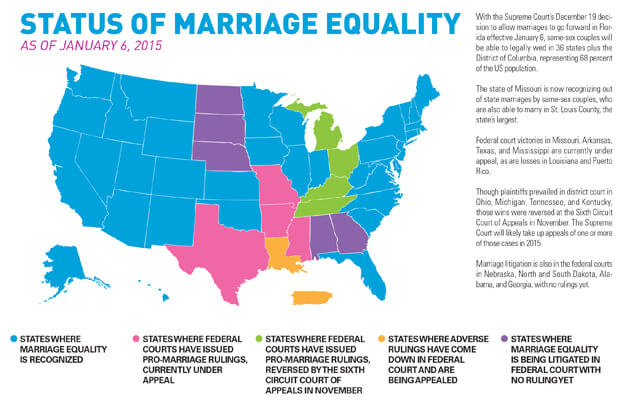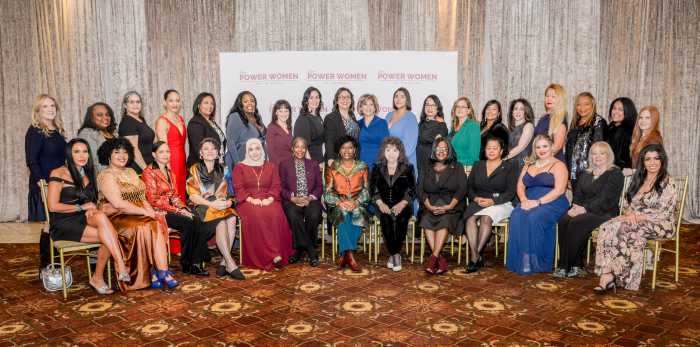Oklahoma marriage plaintiffs Mary Bishop and Sharon Baldwin. | FREEDOM TO MARRY
A three-judge panel of the US 10th Circuit Court of Appeals, on April 17, heard arguments in the Oklahoma marriage case, just a week after considering arguments in the State of Utah’s appeal of the marriage equality ruling there. In a January decision, Senior District Judge Terence C. Kern ruled that Oklahoma’s constitutional amendment banning same-sex couples from marrying was unconstitutional, but found he didn’t have jurisdiction to decide whether the state’s ban on recognizing legal same-sex marriages from other states was constitutional, because the only defendant in the case, Tulsa County Clerk Pat Key, had no role in the recognition of out-of-state marriages.
The county clerk appealed the ruling against her on the marriage ban, and the plaintiffs appealed Kern’s finding he lacked jurisdiction to rule on out-of-state recognition.
Mary Bishop and Sharon Baldwin had been denied a marriage license in Tulsa, while Susan Barton and Gay Phillips were seeking to have their California marriage recognized by Oklahoma.
Don Holladay, the plaintiffs' attorney, might have been better off not appealing the recognition question. As a result of doing so, he got dragged into lengthy questioning on that and next about whether striking down the constitutional ban on same-sex couples marrying was sufficient since the lawsuit did not challenge Oklahoma’s statutory ban as well.
Holladay never really got to argue the merits of anything.
In responding on the out-of-state recognition question, he pointed out that the 10th Circuit had previously ruled that marriage equality plaintiffs erred in suing the governor and the attorney general, whose jobs did not involve administering the marriage laws, and that the correct defendant to sue was the county clerk who denied marriage licenses to same-sex couples. The circuit panel should stick to that finding, he argued, and rule that Kern did have jurisdiction to decide the question of recognizing marriages from outside Oklahoma.
Holladay also noted that the recognition question was somewhat academic, since if the ban on allowing couples to marry is thrown out, it would make no sense for the state to be able to turn around and say those who married out of state would not enjoy recognition of their marriages.
On the question of whether Oklahoma’s statutory ban on gay marriage would survive if the constitutional amendment were thrown out, Holladay, citing state court precedents, argued that when the amendment was adopted, it basically replaced the laws, so that if it falls, they are gone, too.
James Campbell, an attorney for Alliance Defending Freedom, a group active in anti-gay litigation efforts nationwide, stepped in to represent the Tulsa county clerk on the appeal –– and largely repeated the arguments made a week earlier by the attorney representing the State of Utah. He challenged the argument that the plaintiffs’ case is one about sex discrimination, which would have required the court to subject Oklahoma’s constitutional ban to “heightened scrutiny,” a standard most judges and legal observers agree it could not survive.
Campbell also argued the district court lacks jurisdiction to rule on marriage equality at all, citing a 1972 decision by the Supreme Court not to hear –– for “want of a substantial federal question” –– an appeal of a Minnesota Supreme Court ruling denying a gay marriage claim. Relying on the purported precedent from 1972 is an argument that has been rejected by every district court judge ruling on marriage equality since last June’s Defense of Marriage Act decision.
Campbell, when confronted with the argument that last year’s DOMA decision seems to have ignored the high court’s action in the 1972 Minnesota case, replied that DOMA presented a completely different issue than the Oklahoma challenge and asserted that the high court majority last year acknowledged the right of states to decide who can marry.
Judge Carlos Lucero, the one Democratic appointee on the three-judge panel, pointed out that in 1967, when the Supreme Court, in Loving v. Virginia, struck down laws outlawing interracial marriage, it rejected the same kind of argument Campbell was making about sex discrimination –– that the ban treats everyone equally. In Loving, the State of Virginia argued there was no discrimination because blacks and whites were equally prohibited from interracial marriage. Oklahoma, Campbell asserted, is equally prohibiting men and women from entering into same-sex marriages.
In Loving, the high court saw through Virginia’s argument –– miscegenation laws, it found, were adopted to enforce white supremacy. In Oklahoma, the ban on same-sex couples marrying is essentially a way to protect heterosexual supremacy, making the plaintiffs’ case one about sexual orientation. Under 10th Circuit precedent, sexual orientation claims are not subject to heightened scrutiny, but rather rational basis review, which imposes the lightest burden on Oklahoma in defending its ban –– the plaintiffs must show the state has no conceivable justification not based purely on animus toward gays and lesbians.
Questioning and comments from the appeals panel a week before in the Utah case suggested the majority felt the state was in a strong position if that were the standard of judicial review applied –– a view at odds with the conclusions of federal district court judges in an unbroken strings of decisions since last summer’s DOMA ruling. The wave of marriage equality decisions in the past year resulted from findings that state marriage bans lack any rational basis.
Campbell was not content to rest on the assumption the Oklahoma marriage ban need merely survive rational basis review. He argued that even if the amendment were subjected to heightened scrutiny –– where the burden is shifted to the state to show its policy substantially advances an important government interest –– plaintiffs would still have to prove that striking down the amendment would not produce harm in the long run. There is no definite proof, he asserted, that changing the definition of marriage would not have such an effect.
Here, Campbell and the State of Oklahoma seem to have gone off the rails. The state cannot exclude an entire class of people from participating in a central social and legal institution based on an unproven hypothesis there might be long-term ill effects from allowing their participation. Especially when expert opinion on the major danger warned of –– the impact on children raised by same-sex couples –– is so firmly arrayed in favor of the view there would be no harm.
Amidst so much of the argument being far afield from the central matter at issue, little new light was shed on the inclinations of the three judges. Lucero, a Bill Clinton appointee to the court, is likely to vote to uphold the trial court’s ruling, while Judge Paul J. Kelly, Jr., appointed by President George W. Bush, seems disposed to reverse the marriage equality ruling, though he asked few questions during the Oklahoma arguments.
The balance is in the hands of Judge Jerome A. Holmes, also a Bush appointee.
The 10th Circuit panel faces no deadline for reaching a decision in the Utah and Oklahoma cases, but there is competition from other circuits hearing marriage equality appeals. The Fourth Circuit hears oral argument in the Virginia cases on May 13, and arguments will probably occur in June on the Sixth Circuit cases from Michigan, Ohio, Tennessee, and Kentucky.
In an interesting Sixth Circuit development, Roberta Kaplan, who successfully argued Edie Windsor’s DOMA case before the Supreme Court, is trying to intervene on behalf of Equality Ohio, the state’s LGBT rights organization. Kaplan was rebuffed in her effort to intervene on behalf of a new set of Utah plaintiffs in the 10th Circuit. In the Sixth Circuit, she contends –– contrary to the arguments made by the Ohio and the Michigan plaintiffs –– that the cases should go directly to en banc review by the entire circuit rather than to a three-judge panel. That is the same position taken by Michigan Attorney General Bill Schuette, a marriage equality opponent.
Kaplan notes that a three-judge panel would be required to respect existing circuit precedent that a sexual orientation claim be reviewed using the lenient rational basis standard. En banc, the circuit could consider anew the question of what standard of review applies.
En banc review now might also speed the Sixth Circuit cases’ journey to the Supreme Court, especially since both the 10th Circuit and the Fourth Circuit reviews are being handled by a three-judge panel and could be revisited by the circuit en banc before going to the high court.


















